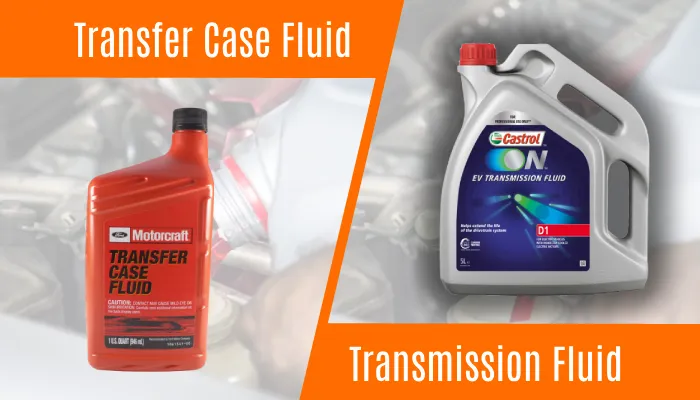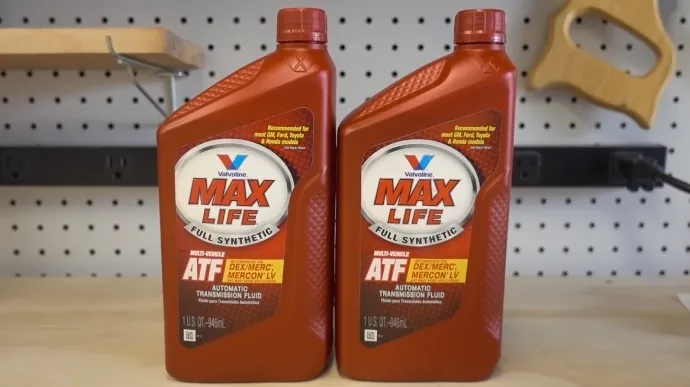Physical Address
304 North Cardinal St.
Dorchester Center, MA 02124
Physical Address
304 North Cardinal St.
Dorchester Center, MA 02124

Transfer case fluid and transmission fluid both play critical roles in the proper functioning of your vehicle. These two types of fluids serve different purposes and operate under various conditions, which makes it essential to understand their differences.
One difference between transfer case fluid and transmission fluid is their intended operating areas. Transfer case fluid is specifically formulated for use in the transfer case. The transfer case’s primary responsibility is distributing power to the vehicle’s axles.
In contrast, transmission fluid is intended for use within the vehicle’s transmission, which plays a crucial role in gear shifting and power transmission.
We will explore the distinctions between transfer case fluid and transmission fluid in more detail, including their viscosity ratings, heat resistance, and other properties.

Transfer case fluid and transmission fluid differ in some categories, with distinct characteristics that set them apart. Here are six key differences between these essential vehicle lubricants.
To properly understand the distinctions between transfer case fluid and transmission fluid, you need to know where each fluid operates.
Transfer case fluid is specifically designed for use in the transfer case, which is a component located in 4WD or AWD vehicles. The transfer case is responsible for distributing power from the transmission to the front and rear axles, allowing for different drive configurations.
On the other hand, transmission fluid is intended for use in the vehicle’s transmission. The transmission plays a central role in gear shifting, power transmission, and torque conversion. It’s responsible for ensuring smooth and efficient gear changes.
Both fluids have distinct operating areas and serve different functions in the vehicle’s drivetrain system.
Understanding the viscosity ratings is essential for distinguishing between transfer case fluid and transmission fluid.
Transfer case fluid typically has a higher viscosity, indicated by specifications such as SAE 75W-90. This higher viscosity is necessary to ensure proper lubrication and protection for the gears within the transfer case.
Conversely, transmission fluid has a lower viscosity, making it thinner and more suitable for flowing through the intricate components of the transmission. Common viscosity ratings for transmission fluid include SAE 10W, 5W, or other low-viscosity grades, depending on the specific transmission type.
Transfer case fluid and transmission fluid differ in their heat resistance capabilities. The Transfer case fluid is specifically formulated to withstand extreme heat and temperature variations that can be generated during the operation of the transfer case.
Its ability to dissipate heat effectively is crucial in preventing overheating and maintaining proper lubrication.
In contrast, transmission fluid has a lower boiling point compared to transfer case fluid. While it can handle the normal operating temperatures of a transmission, it may not provide the same level of heat resistance as transfer case fluid.
When choosing transfer case fluid or transmission fluid, it’s important to consider their specific API ratings. These ratings indicate the level of protection and performance the fluid offers for the gears within the transfer case or transmission.
For transfer case fluid, you may come across API GL-4 or similar designations, which ensure that the fluid provides the necessary protection for the transfer case gears.
Meanwhile, transmission fluid may have different API ratings depending on the transmission type. For manual transmissions, you might find API MT-1, while for automatic transmissions, API SP is commonly used.
These API ratings guarantee that the fluid meets the specific requirements of the transmission, ensuring optimal performance and longevity.
As you consider the differences between transmission fluid and transfer case fluid, it’s important to understand the significance of their respective colors.
Transfer case fluid is typically clear with hues of dark red, resembling a translucent dark red when fresh. Even with time and use, it usually remains clear with a hint of dark red.
On the other hand, fresh transmission fluid is vibrant red, making it easily distinguishable. However, as transmission fluid ages and becomes contaminated, it gradually changes to a darker color, often appearing black or brown.
Transfer case fluid is generally less expensive due to its lower volume requirement and simpler composition. A 1-quart container of transfer case fluid typically ranges from approximately $9.77 to $37.05, depending on the brand and retailer.
Conversely, transmission fluid tends to be more expensive because of its larger volume requirement and more complex formulation. A 1-quart container of transmission fluid can range from as low as $6.34 to as high as $34.99, depending on the brand and type.
Synthetic transmission fluids, offering improved performance and durability, are usually pricier than conventional ATF.
| Aspect | Transfer Case Fluid | Transmission Fluid |
| Operating Area | Transfer case-specific for 4WD and AWD vehicles, distributing power to axles. | Transmission-specific, enabling gear shifts and power transmission. |
| Viscosity Ratings | Higher viscosity, often SAE 75W-90, to protect transfer case gears. | Lower viscosity, e.g., SAE 10W, for transmission’s intricate components. |
| Heat Resistance | Engineered to withstand extreme heat generated in the transfer case. | Capable of handling normal transmission temperatures, with cooling systems. |
| Specific API Ratings | May require API GL-4 or similar to protect transfer case gears. | Varied API ratings, e.g., API MT-1 for manual and API SP for automatic transmissions. |
| Color | Clear with a hint of dark red, remains clear over time. | Vibrant red when fresh, darkens to black or brown with use and contamination. |
| Cost (1-Quart Container) | Ranges from about $9.77 to $37.05, generally more economical. | Ranges from about $6.34 to $34.99, often a larger investment due to complexity and volume. |

You can use transmission fluid in your vehicle’s transfer case. It is important to note that this applies mostly to automatic transmissions. For manual transmissions, gear oil is typically used. Transfer case fluid is recommended first and foremost.
However, if the situation arises where you do not have access to transfer case fluid, ATF can be a suitable substitute in many cases. It is always best to refer to your vehicle’s owner’s manual for specific recommendations on which fluids to use in your transfer case.
Generally, it’s advisable to change the transfer case fluid every 20,000 to 30,000 miles. This interval ensures that the transfer case remains properly lubricated, which is crucial for its smooth operation.
As for the transmission fluid, it’s typically recommended to be replaced every 60,000 to 80,000 miles. Regularly changing the transmission fluid helps maintain its viscosity and lubricating properties, allowing the transmission to shift smoothly and reducing wear on its internal components.
However, it’s important to note that these intervals can vary depending on your specific vehicle make and model, so always consult your owner’s manual for precise recommendations tailored to your vehicle.
Both transfer case fluid and transmission fluid serve distinct purposes, ensuring the smooth operation of your vehicle. Understanding their differences, such as operating areas, viscosity ratings, heat resistance, API ratings, color variations, and cost disparities, is crucial for proper maintenance.
Always adhere to the recommended fluid replacement intervals for your transfer case and transmission to maintain optimal performance.
Regular maintenance and using the right fluid for each component ensure longevity and efficient operation of your vehicle’s critical systems.